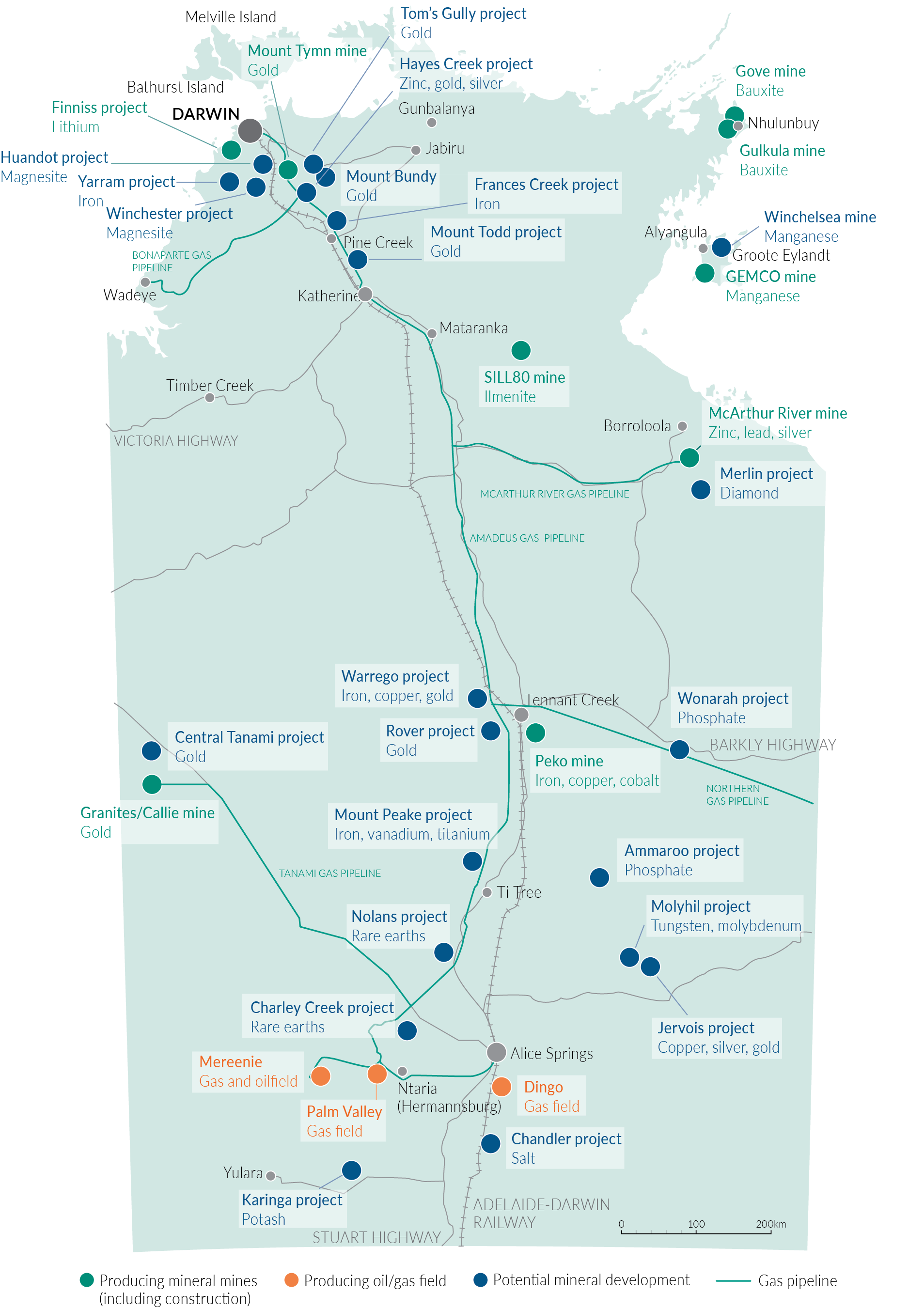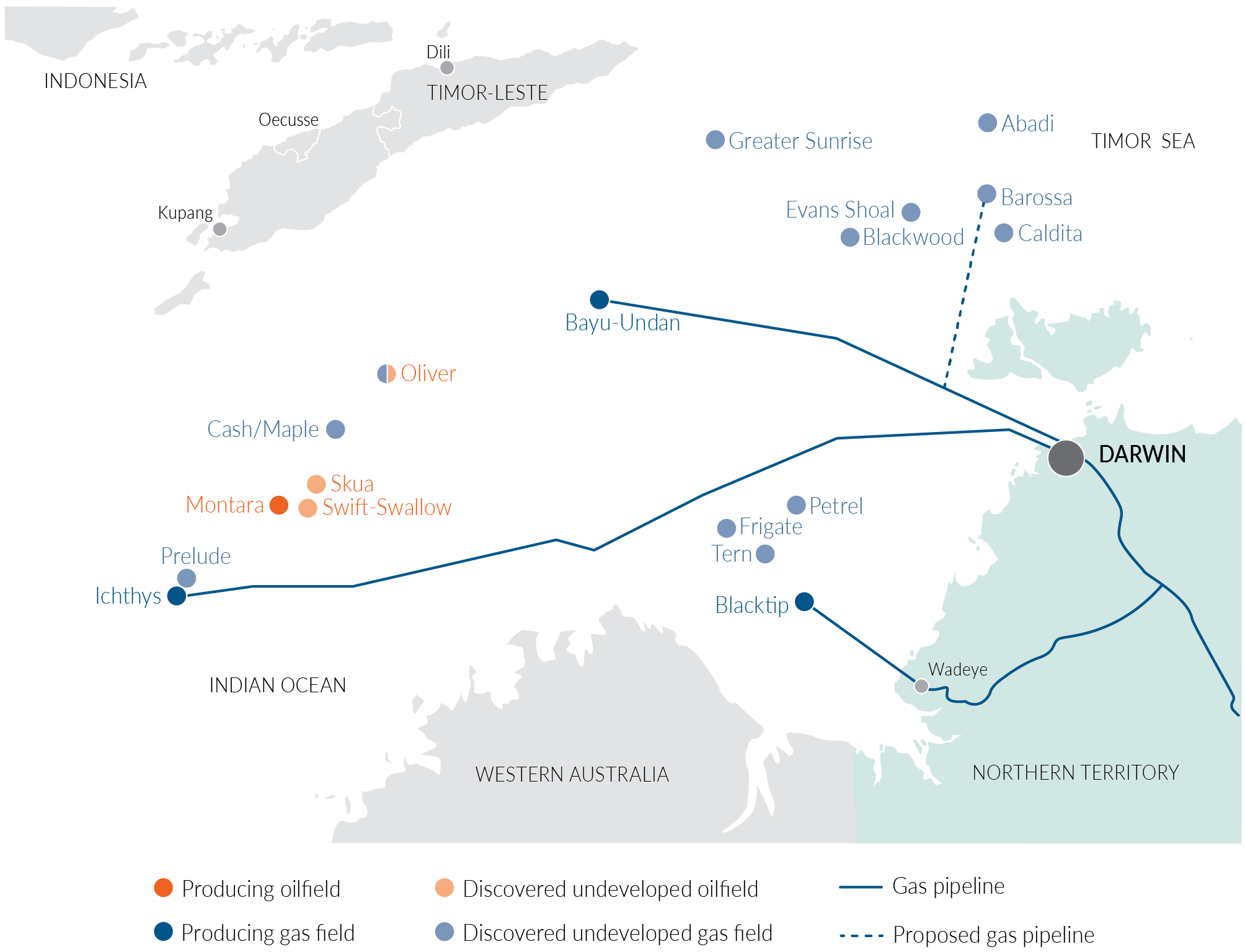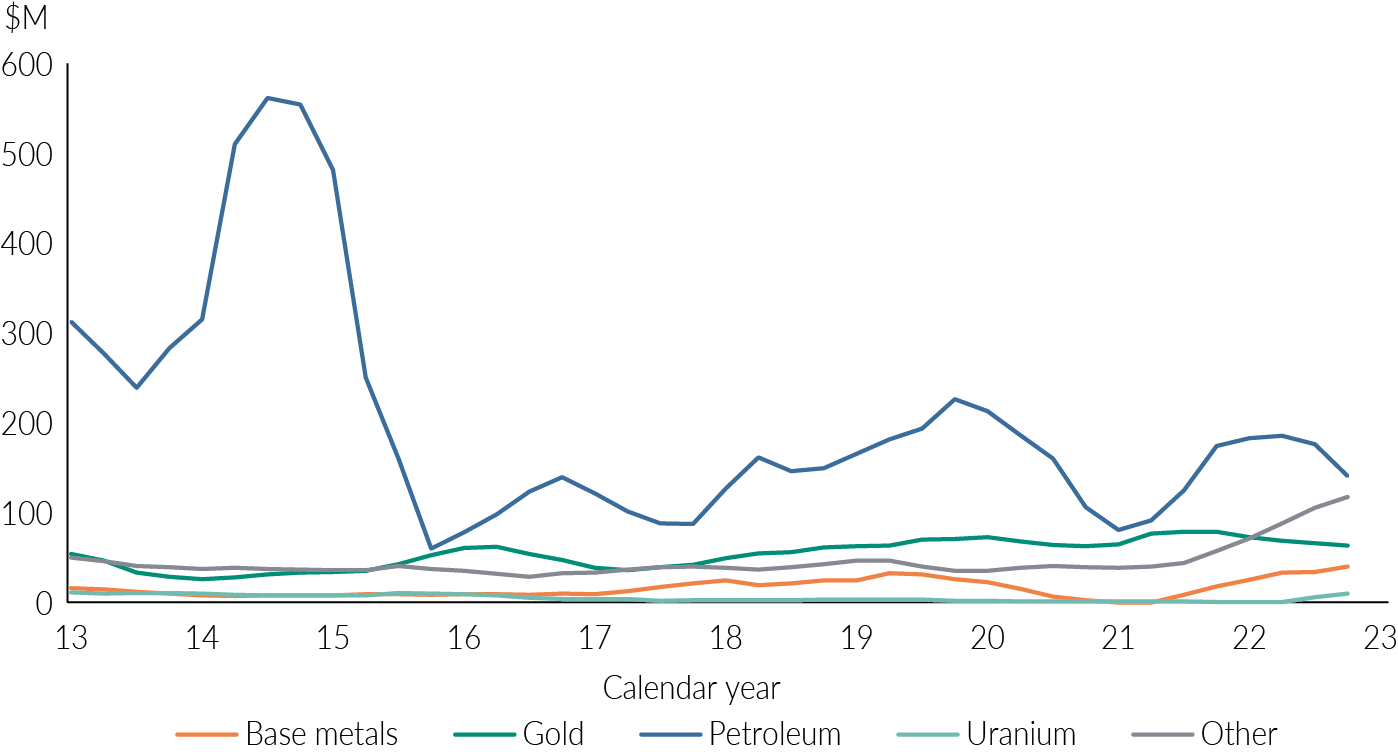Mining and manufacturing
Outlook
The gross value-adding activity of the mining and manufacturing industries is expected to decline in 2022-23 before recovering over the rest of the outlook period as the Darwin LNG plant transitions from the Bayu-Undan field to the Barossa field, which is due to come on line in 2025. Over the outlook period, progress will also be made towards transforming Middle Arm into a globally competitive sustainable development precinct.
In 2021-22, the mining industry comprised 31.7% of GSP, the largest contributor to the Territory economy. The manufacturing sector accounted for 3.6%. Mining employed 2,527 persons, and manufacturing employed 3,445 persons, accounting for 1.9% and 2.6% of total Territory employment respectively. In real terms, the Territory mining sector’s gross value added increased by 13.4% to $5.7 billion, while manufacturing increased by 12.6% to $1.1 billion.
Mining output is dominated by LNG and metallic minerals. The sector contributes to the Territory economy through international trade, private investment and employment. The mining industry also has a large impact on the Territory’s construction industry, as mining development generates significant levels of construction activity.
Production output from the Ichthys LNG plant is expected to increase in 2023 and then remain stable over the following years. However, gas reserves from the Bayu‑Undan field are expected to deplete in mid 2023, with production from the Barossa field expected to commence in 2025.
Demand for critical minerals will be particularly strong given their use in energy-efficient technology and as countries increase efforts to transition to low-carbon energy. This comes amid a backdrop of supply bottlenecks and steep fuel prices that resulted from the Russia-Ukraine conflict. There are a number of projects pending final approvals, which if realised, will boost mineral production in the Territory. These projects include:
- Jervois copper mine
- Mount Peake iron, vanadium and titanium mine
- Nolans rare earths mine
- Mount Todd and Mount Bundy gold mines
- Warrego tailings project and Frances Creek iron ore mine
- Winchelsea manganese mine
- Molyhil tungsten mine
- Merlin diamond mine.
In April 2023, the Territory Government released the Mineral Development Taskforce Final Report. It outlines how the Territory can accelerate mining development by increasing private investment in mining and downstream value-add projects. A series of recommendations have been made with a focus on encouraging exploration activity and streamlining procedures to enhance the Territory’s competitiveness as an investment destination.
Minerals production
The majority of minerals produced in the Territory are metallic, including lithium, gold, manganese, zinc, lead and bauxite (Map 1). The Territory also produces non-metallic minerals, such as crushed rock, sand, quicklime and gravel.
The value of the Territory’s mineral output was $4.9 billion in 2021-22, a 13.6% increase from the previous year in current prices. This represents the second highest value of mineral output and was largely due to an increase in the value of manganese, and zinc/lead concentrates (Chart 3). The value of the Territory’s mineral production is expected to decline in 2022-23 to $4.7 billion before rising to $5.4 billion in 2023-24.
Chart 3: Value produced of selected Territory minerals
Source: Department of Industry, Tourism and Trade
Manganese
Manganese is an input to steel manufacturing, and production is largely driven by global steel demand. In the Territory, manganese is produced at the Groote Eylandt Mining Company (GEMCO) mine, the largest manganese mine in the world, and previously at the Bootu Creek mine, which stopped producing in December 2021 (Map 1).
In 2021-22, the value of manganese produced increased by 21.2% (Chart 3), driven by an increase in the global price for the commodity. Manganese accounted for 36.5% of the value of all minerals produced by the Territory.
In 2022-23, the value of production is forecast to decline due to lower quantities produced resulting from the closure of the Bootu Creek mine. This will be partially offset by a slight increase in the price of manganese. The GEMCO mine is expected to continue to operate near capacity, so long as global demand for steel remains strong.
Gold
The Territory produces gold from the Granites mine in the Tanami region and Mount Tymn just south of the Adelaide River (Map 1). The value of gold produced increased by 4.2% in 2021-22, accounting for 25.5% of the value of all minerals produced by the Territory. This was driven by modest increases in both price and production.
In 2022-23, expansion activities at the Granites mine will be less disruptive on operations compared to the previous year. This, together with elevated prices resulting from strong demand, is expected to increase the value of gold production this year.
The completion of expansion activities at the Granites mine, together with the Nobles Nob mine, expected to become operational in 2024, will contribute to production levels increasing over 2023-24 and 2024-25.
Zinc and lead
Zinc and lead are produced at the McArthur River mine located 65 kilometres south-west of Borroloola (Map 1). The value of zinc and lead produced increased by 26.9% to $1.2 billion in 2021-22, due to an increase in both price and quantity produced.
In 2022-23, the value of production is expected to decline as prices moderate and there is a slight decrease in production levels.
Bauxite
Two bauxite mines operate in the Territory – Rio Tinto’s mine at Gove and Gulkula’s mine on the Dhupuma Plateau (Map 1).
The value of Territory bauxite produced decreased by 15.2% to $396.8 million in 2021-22, reflecting a decrease in price and quantity produced. Bauxite prices are expected to decline over the short-term due to an expected decrease in global demand for aluminium.
Iron ore
In 2021-22, the value of iron ore produced in the Territory decreased by 18% to $60.4 million due to the closure of Nathan River mine in October 2021 resulting in lower iron ore production.
Output is forecast to remain low in 2022-23 as production occurs only from the Peko mine. In 2023-24, output is then expected to increase as the Peko mine builds towards its target production levels, and the Warrego Tailings mine and Frances Creek mine reopen in the second half of 2023.
Lithium
Lithium is a crucial mineral in the transition to net zero carbon emissions and will help diversify the Territory’s economic base.
The Finniss lithium project opened in October 2022, making the Territory an emerging supplier of lithium. The value of lithium production in 2022-23 is forecast to be $68 million. Part of this comes from the export of 15,000 tonnes of unprocessed lithium ore to China in January 2023 and the rest will be from the production of spodumene concentrate, with the first shipment expected in May 2023. The start of spodumene production will help the mine to gradually approach its planned levels of production for a 12-year mine life.
The value of production is expected to increase over 2023-24 with two binding agreements already in place for the supply of 375,000 tonnes of lithium concentrate over four years.
Uranium
Production at the Ranger mine ceased in January 2021. Uranium accounted for 3.4% of the total value of the Territory’s mineral production in 2021-22 as remaining inventory was sold off. Energy Resources of Australia Limited’s rehabilitation of the Ranger mine is currently underway and expected to continue until at least 2028.
The Territory contains around 30% of Australia’s low cost uranium resources with two projects currently under feasibility in the eastern Pine Creek region and the Ngalia Basin.
Other minerals
The value of production of non-metallic minerals increased by 29.8% to $52.7 million in 2021-22. This was driven by increases in the quantity produced for crushed rock, gravel and sand.
Most non-metallic mineral production is for Territory consumption and responsive to changes in construction activity. The value is expected to increase in 2022-23 and 2023-24 due to greater quantities produced.
Map 1: Current and pending mineral and onshore petroleum operations in the Territory1
1 This map is produced from various sources. Department of Treasury and Finance cannot guarantee the accuracy, currency or completeness of the information. To be used as a guide only.
Source: Department of Industry, Tourism and Trade; Department of Treasury and Finance
Oil and gas production
The Territory’s onshore oil and gas is currently conventional in nature and sourced from the Amadeus Basin in Central Australia. Production occurs at the Mereenie, Palm Valley and Dingo fields operated by Central Petroleum Limited.
Onshore gas production increased by 0.6% to 14.3 billion cubic feet in 2021-22. The increase results from commissioning new production wells at the Mereenie field and increased demand from the Owen Springs power station, which is supplied with gas from the Dingo field. Production was further supported by increased demand from the eastern states with Central Petroleum supplying uncontracted gas to them for the first time in May 2022.
Onshore oil production occurs only at the Mereenie field and was down by 2.5% to 0.16 million barrels in 2021-22. This came about as new wells were positioned to target gas extraction instead of oil.
The Territory’s offshore gas is sourced from the Ichthys, Blacktip and Bayu-Undan fields. Gas from the Ichthys and Bayu-Undan fields is transported to onshore processing facilities to be exported to global markets, whereas gas from Blacktip is used primarily for domestic consumption. The Bayu-Undan field supplies gas to Santos’ Darwin LNG plant and is expected to deplete in mid 2023. Construction works to bring its replacement, the Barossa gas field, into production are 56% complete, with production anticipated to begin in 2025. The lag between reserves at Bayu-Undan exhausting and the Barossa field coming on line will result in a temporary cessation of production at Darwin LNG in 2023-24. Production from the Ichthys LNG plant is expected to increase in 2023 and then remain stable over the rest of the outlook period.
Offshore oil is produced mainly from the Montara field and is exported overseas. The value of the Territory’s offshore oil exports decreased from $47.7 million in 2020-21 to $5.3 million in 2021-22. This outcome is likely a result of reduced operations at the Montara field due to drilling activity in the second half of 2021 and unplanned maintenance activities in the first half of 2022. However, caution is advised when interpreting this result as a large proportion of trade data has been confidentialised by the ABS. The value of offshore oil exports in 2022-23 is expected to remain low due to additional maintenance shutdowns at Montara field resulting from discovering technical defects and oil leaks into the Timor Sea in June 2022.
Map 2: Offshore petroleum activity near the Territory1
1 This map is produced from various sources. Department of Treasury and Finance cannot guarantee the accuracy, currency or completeness of the information. To be used as a guide only.
Source: Department of Industry, Tourism and Trade; Department of Treasury and Finance
Exploration activity
Exploration does not always lead to the development of new mines but levels of exploration activity can be a lead indicator of future development.
Total mineral exploration expenditure in the Territory increased by 29% to $198.6 million in 2022, the highest it has been since 2011. This reflects increased expenditure across base metals, uranium and other non-metallic minerals, as well as greater exploration activity in greenfield areas (Chart 4).
Petroleum exploration activity in the Territory is focused on the Beetaloo Sub-basin and the Amadeus Basin. Santos, Tamboran Resources and Empire Energy Group are the main companies exploring in the Beetaloo Sub-basin currently. Petroleum exploration expenditure in the Territory decreased by 19.4% to $140.4 million in 2022. With a limited number of companies exploring the region, expenditure is subject to large volatility based on the scope of their activity. The decrease in exploration expenditure is likely a result of exploration activity conducted by Santos being limited to well testing rather than drilling new wells.
Expenditure is anticipated to increase in 2023, as Empire Energy makes progress on commercialisation following encouraging results from testing gas flow, and Tamboran Resources commences a well stimulation program aimed at improving the flow of gas.
Exploration activity for helium and hydrogen within the Amadeus Basin is expected later in 2023, which will further support the Territory’s total exploration expenditure.
Chart 4: Value of mineral and petroleum exploration expenditure in the Territory1
1 Moving annual total.
Source: ABS, Mineral and Petroleum Exploration, Australia, Cat. No. 8412.0.
Manufacturing
In 2021-22, significant manufacturing industries in the Territory included food products, fabricated metals and transport equipment.
In 2021, the Territory Government entered into a partnership with the Advanced Manufacturing Growth Centre (AMGC) to support the development of advanced manufacturing in the Territory. As part of this partnership, AMGC and the Territory Government have established the Advanced Manufacturing Ecosystem Fund (AMEF) to support local businesses to commercialise products using innovative technology. So far the AMEF has supported Diverseco, Katherine Joinery, Arctic Installations, Air Tip and Corrosion Instruments. In March 2023, Diverseco opened its Darwin manufacturing innovation hub, which will enable Territory businesses to access automation services and solutions to increase productivity. In addition, Diverseco is collaborating with the Charles Darwin University to develop robotic and automation-related qualifications to improve local workforce capabilities.
The Territory Government is also investing $10 million in a joint venture with Amphibian Aerospace Industries (AAI) to manufacture the amphibious Albatross aircraft at Darwin airport. In December 2022, AAI established a research and development centre at Darwin airport with the new aircraft expected to become available within the next five years.
To support the Territory’s role as an LNG export hub and fully realise the potential of the manufacturing sector, the Territory Government is working towards establishing the Middle Arm Sustainable Development Precinct. The focus of Middle Arm will be on enhancing downstream activities by setting up low-emission advanced manufacturing and processing facilities.
- Previous Service industries
- Next Construction



